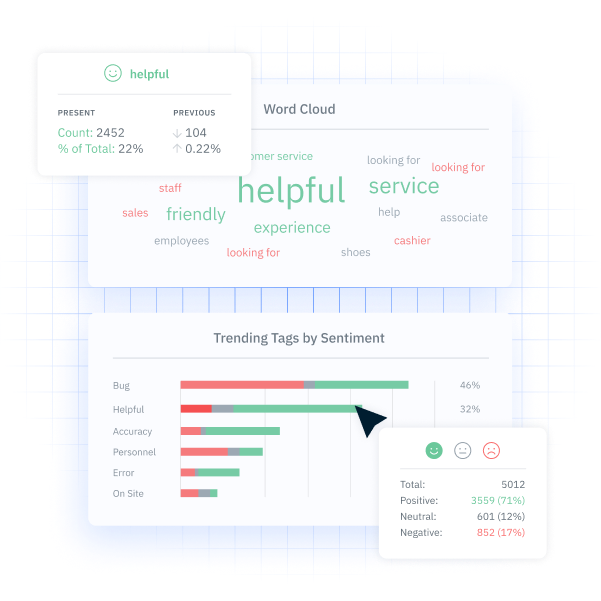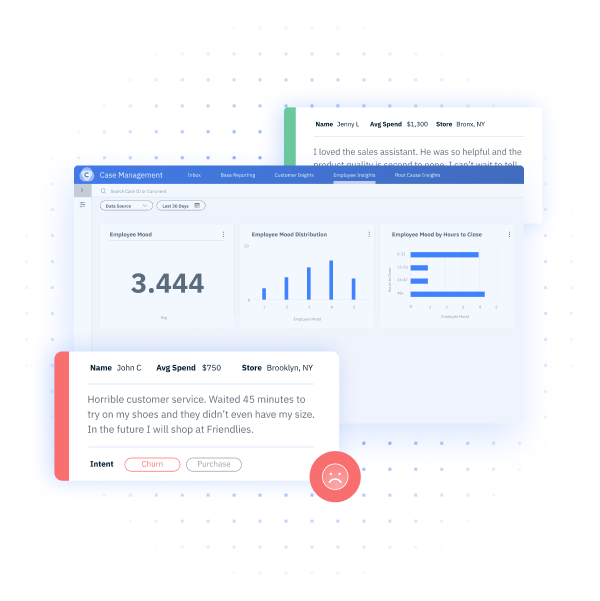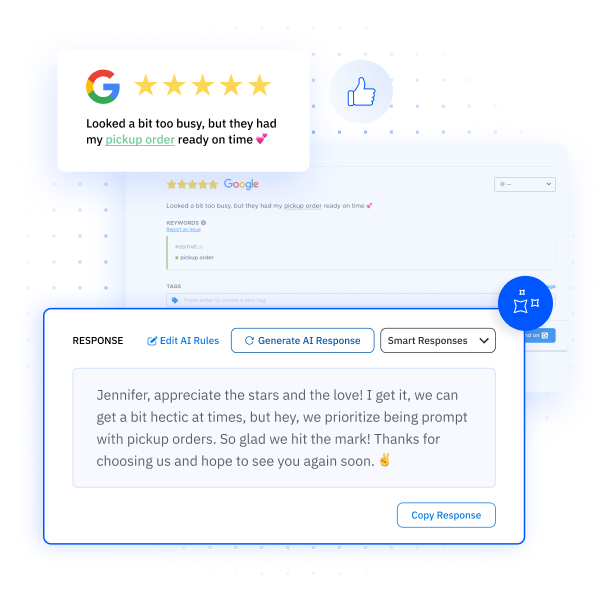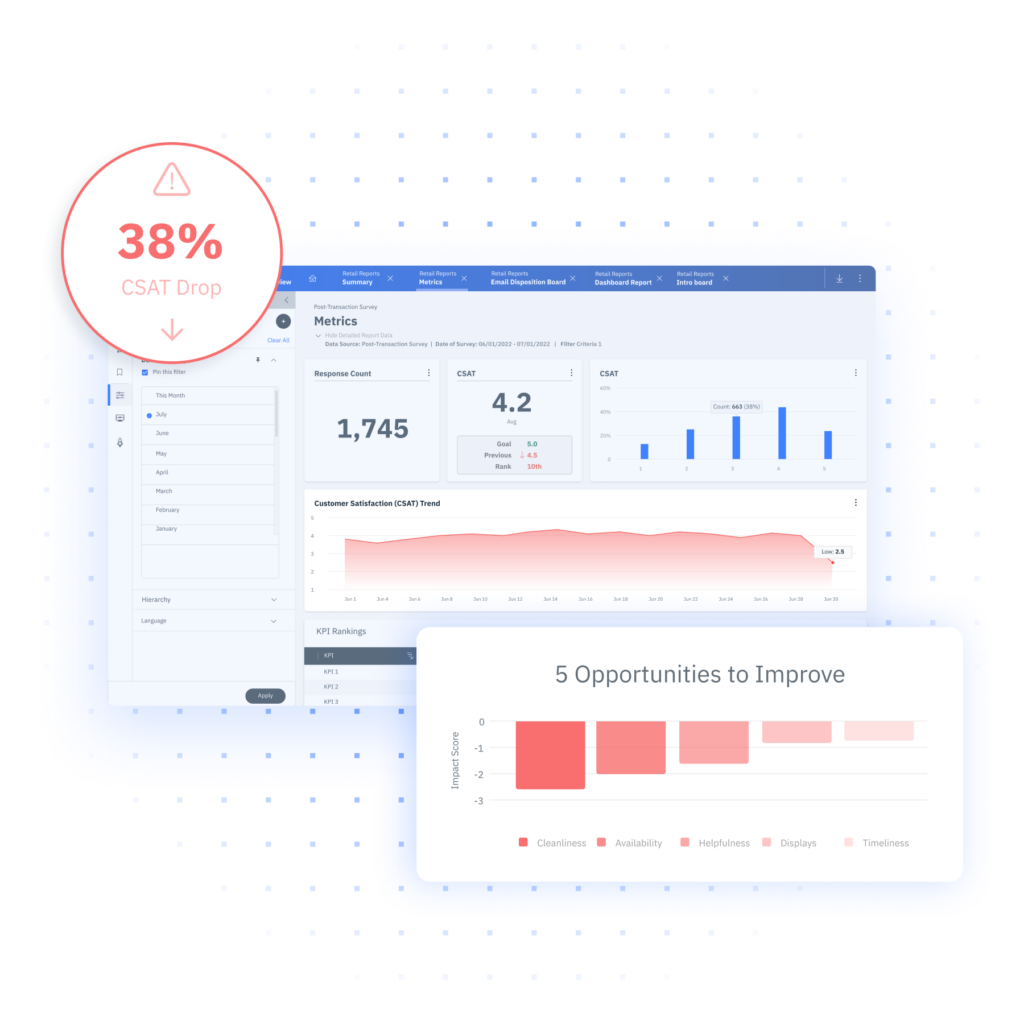How to Improve Customer Experience In Your Organization
Working to improve customer experience is an important part of CX management and something that organizations should be continuously striving for. If your customer experience does not evolve with your business, it can negatively impact your revenue and overall business performance.
Did you know that when you improve customer experience, you can realize financial benefits that directly affect the growth of your organization? By improving customer experience, you can:
- Increase sales revenue by up to 7%
- Increase cross-sell rates by up to 25%
- Increase shareholder return by up to 10%
These statistics show that customer experience improvement is something that should be a priority across your entire organization, rather than being a siloed effort.
What is Customer Experience Improvement?
Customer experience improvement refers to enhancing the interactions and overall satisfaction a customer has with your business across all touchpoints. This involves understanding customer needs and expectations, as well as any pain points they have in the customer journey, and working to address them.
The goal of customer experience improvement is to create a positive customer experience where the customer always feels supported.
What is A Customer Experience Improvement Program?
A customer experience improvement program is a structured initiative designed to enhance the interactions a customer has with a brand. Customer experience programs are built upon strategies for gathering customer feedback, analyzing voice of the customer data, and implementing changes to the customer experience.
A customer experience program helps your organization improve customer experience by facilitating cross-functional collaboration between various departments such as sales, marketing, support, etc.
Benefits of Improving Customer Experience
When you improve customer experience, you will notice benefits that reach every part of the organization. Some of the benefits of improving customer experience include:
Increased Customer Loyalty
When you have a consistently positive customer experience, you will create loyal customers. Customers will become loyal to your brand after a varying number of positive experiences. 50% agree that it takes between three and four purchases, while 37% agree it takes more than five purchases. But, by improving customer experience, you will have no problem achieving these customer milestones and increasing customer loyalty.
Higher Customer Lifetime Value
Satisfied customers tend to spend more over time, especially when compared to new customers. By improving customer experience, you increase the customer lifetime value by encouraging repeat purchases, cross-selling, and upselling opportunities.
Improved Customer Satisfaction
You will increase customer satisfaction by improving customer experience and reducing the pain points in the customer journey. As a result, those satisfied customers will be more likely to recommend your products or services to others.
Enhanced Brand Reputation
When you improve customer experience, customers will trust you more. And 88% of customers who trust a brand will become repeat customers. Improving customer experience will also result in increased brand equity, which is a key determining factor in what organizations consumers choose to give their business to.
Stronger Competitive Advantage
In competitive industries, customer experience is often a key differentiating factor. As a matter of fact, 93% of businesses cite CX as either a primary differentiator or a partial differentiator. Improving the customer experience will help your business stand out in the market and attract more customers.
10 Ways to Improve Customer Experience
It can be easy to get overwhelmed with all the things that can be done to improve customer experience for your organization. However, these ten action items represent the most important and impactful factors of the customer experience.
1. Listen to Customer Feedback
Most companies receive customer feedback, but few organizations take the steps necessary to listen to and implement customer feedback in their organization. It is important that you actively examine the voice of customer data to understand what is going well, and what could be improved, in your customer experience. You can also improve customer experience by utilizing tools like sentiment analysis, which will help you analyze unstructured data.
How Can Sentiment Analysis Be Used to Improve Customer Experience
Sentiment analysis can be a powerful tool for improving customer experience by providing real-time insights into how customers feel about your products or services. By analyzing text data from reviews, social media, surveys, and support tickets, your business can identify trends in customer emotions as well as promptly address complaints, and adjust your offering based on customer sentiments.

2. Personalize Interactions
The majority of today’s consumers expect personalized interactions. You can improve customer experience by tailoring communications and offerings based on individual customer behaviors.
Examples of Personalized Interactions
For example, an e-commerce website might suggest a hat to go with a recently purchased shirt. Or a financial services institution might notice a customer opening a new savings account and suggest they meet with an in-house financial advisor.
3. Streamline Processes
One of the best ways to improve customer experience is to improve organizational performance. If your organization is operating efficiently, your customers will almost certainly experience an efficient experience. For example, undergoing contact center optimization may help customer profiles become more easily accessible to agents. If agents can access customer information easier, they can improve issue resolution time and, as a result, improve the customer experience.
4. Train Employees
You can improve customer experience by ensuring that your employees are equipped with the knowledge and skills needed to deliver excellent service. Furthermore, suppose you understand the importance of employee loyalty. In that case, you know that employee retention is crucial in keeping costs low so that more time and effort can be spent trying to improve customer experience.
Employee training goes beyond the onboarding process. It is also important to effectively manage and train employees continuously throughout their careers. Tracking employee statistics and their engagement with customers will help you train them to provide the best service.

5. Reduce Customer Churn
It might seem counterintuitive to try and improve customer experience by decreasing customer churn. But, the two are closely related. If you analyze your customer churn rate and find out what is driving churn, you can implement initiatives to eliminate churn factors in your organization.
By removing the things that are causing your customers to leave, you will give them more of a reason to stay, which will improve customer experience.
6. Reward Loyal Customers
Implement a customer loyalty or rewards program that acknowledges and incentivizes repeat business. 83% of consumers say that belonging to a loyalty program influences them to buy from a brand again. By offering discounts, early access to new products, or other perks, you can retain loyal customers by creating a sense of appreciation and rewarding them for doing business with your brand.
7. Offer Self-Service Options
79% of consumers expect organizations to provide self-service tools, and 77% view organizations more positively when they do. By offering self-service options, you can help customers save time while simultaneously reducing the pressure on support teams. This leads to overall increased issue resolution and increased satisfaction.
8. Respond to Reviews
Responding to reviews is an important part of improving the end-to-end customer experience. Pearl-Plaza research shows that the majority of consumers expect organizations to respond to reviews within a week, but 63% of consumers say they’ve never heard back from a business after leaving a review. Responding to reviews is an important part of making your customers feel valued and understand the real-time performance of your customer experience efforts.
With Pearl-Plaza’s reputation management software, you can utilize AI to generate review responses. The responses can be tailored to your organization to match your brand’s tone and style guidelines. This functionality can make sure all customer reviews receive a response in a timely manner.

9. Create an Omnichannel Experience
An omnichannel customer experience allows customers to have a consistent journey across all platforms whether online, in person, via mobile app, or over the phone. Customers should be able to switch channels without having to repeat information or experience a delay. By creating an omnichannel experience, you make it easier for your customers to interact with your brand how they want to, which will improve their experience.
10. Track Customer Experience Metrics
You can continuously work to improve customer experience by tracking customer experience KPIs. You can use metrics such as Net Promoter Score (NPS), Customer Satisfaction (CSAT), and Customer Effort Score (CES) to monitor specific aspects of your customer experience and identify areas of improvement. By attaching metrics to your customer experience efforts, you make it easier to ensure that customer needs are consistently met and also gives you the ability to show customer experience ROI to key stakeholders in your organization.
Pearl-Plaza’s XI Platform gives you an overview of how your organization is performing on your most important metric, with the ability to dive deeper into specific aspects of the reporting. The XI platform also identifies the biggest areas for improvement to help you continue to realize CX success.

Improving customer experience is an initiative that requires alignment throughout your entire organization. While the tips listed above represent a great starting point in your customer experience improvement journey, some industries require more specific focuses to move the needle.
How to Improve Customer Experience in Retail
The ecommerce customer experience for retail brands has become increasingly important as consumers spend more time online shopping each year. In order to improve the overall retail experience, you need to take into account the ways in which your customers prefer to shop. Here are some tips to improve customer experience in retail:
1. Offer Omnichannel Shopping Experiences
Retail consumers expect to switch between channels during their shopping experience easily. In the last 5 years, buy online pickup in store (BOPIS) orders have increased by over 200%. This means that more consumers than ever are starting their shopping online, and finishing it in-store. To account for this, ensure that your store is up to date with the latest technology so that these orders can be completed seamlessly.
2. Implement Virtual Try-Ons
Using augmented reality technology to allow customers to try products virtually will enhance their shopping experience. One retailer saw that when a customer engaged with AR technology, they had a conversion rate that was 90% higher than customers who did not engage with the same technology. Utilizing this technology creates an interactive and engaging experience that helps customers make informed decisions and reduces returns.
3. Curate Personalized Product Recommendations
88% of consumers are more likely to continue shopping with a brand that gave them a personalized experience, and 68% of consumers bought an item that they didn’t intend to based on recommendations. Using customer data to curate personalized product recommendations will increase customer loyalty and customer lifetime value.
How to Improve Customer Experience in Financial Services
The financial services customer experience has changed a lot in recent years. Consumers are rarely visiting branches, and digital banking usage has increased exponentially. However, there are some values that all financial consumers share, and capitalizing on those will help your institution improve customer experience.
1. Implement Personalized Financial Advice
Use data analytics to provide personalized financial advice based on customers’ spending habits, life stages, and goals. For example, Pearl-Plaza research found that 25% of Gen Z and Millennials were not interested in pensions and retirement plans. These customers would prefer to hear about other money management opportunities. Consider implementing online portals or virtual advisor meetings that allow for these consumers to get personalized advice. Offering tailored financial advice will make customers feel valued and increase customer loyalty.
2. Focus on Security and Fraud Prevention
Pearl-Plaza research found that 90% of financial consumers were concerned about cybersecurity. In order to retain these customers, they need to trust that your organization will keep their data secure. Implementing advanced fraud detection systems, offering two-factor authentication, and regularly educating customers on cybersecurity practices can enhance trust and create a sense of security.
3. Develop Financial Literacy Programs
One of the best ways to retain financial services customers is to assist in their education. Offering educational resources such as webinars, tutorials, or guides, can empower customers to educate themselves and make informed decisions. By supporting financial education, you show your customers that you care about their long-term financial well-being.
How to Improve Customer Experience in Healthcare
In order to improve customer experience in healthcare, you need to make it easier for patients to engage with your practice. In an increasingly digital world, patients are spending less time making phone calls to a provider’s office and spending more time researching and booking appointments online. Here are three main things you can do to improve the healthcare customer experience.
1. Simplify Appointment Scheduling
The majority of consumers prefer to book appointments through digital channels such as online or via a mobile app as opposed to calling an office. To match this demand, make sure your practice has user-friendly scheduling systems that can be accessed from multiple devices. By offering these services along with appointment reminders, you make it easier for new and current patients to book and attend their appointments.
2. Manage Local Listings and Reviews
It has never been more important for healthcare providers to have up-to-date information online. The quality and completeness of a provider’s profile is the most important factor to someone looking to book an appointment. Reviews are also important, as patients read an average of five reviews before choosing a provider.
Consider choosing a local listings management software to help you ensure that your practice has the most accurate information available to prospective patients. This can also be used alongside a review management platform that will help you monitor and respond to reviews across the most important sites such as Google, Yelp, and Healthgrades.
3. Build Mobile-Friendly Pages
When conducting research and reading reviews about a provider, almost 70% of patients prefer to use a smartphone or tablet. Similarly, the use of laptops or desktops to do this same research has dropped by almost 30%. In order to make your pages available to consumers on all devices, make sure that your website can support mobile devices, tablets, and desktop computers. This functionality will allow all consumers to view information about your practice and read reviews with ease.
Why Improving Customer Experience Is Important for Organizational Performance
Improving customer experience is important for organizational performance because it can directly affect the amount of revenue your organization generates. Forrester research shows that improving your CX Index score by just one point can generate anywhere from $36 million to $1.2 billion in additional annual revenue depending on your industry.
Improving customer experience gives customers more of a reason to stay customers, as well as recommend your organization to others. By finding the relationship between CX and growth in your business, you can accurately predict the financial improvement driven by CX improvement.
How to Start a Customer Experience Improvement Program
Starting a customer experience improvement program is a step forward to becoming a customer-focused organization. When starting from scratch, there are three important things to consider to improve customer experience.
1. Define the Vision and Goals
Start by outlining the kind of customer experience your organization is trying to deliver. This should align closely with your brand’s values and overall business strategy. Furthermore, choose which customer experience metrics your customer experience improvement program will track. You can choose between customer satisfaction (CSAT), Net Promoter Score (NPS), customer effort (CES), or any other metric that makes sense for your business.
2. Secure Executive Support
It is important to make sure that the leadership and executive team at your organization understand the importance of CX and are committed to supporting the program. This will help secure resources and drive organizational alignment.
After you have received executive support, you will want to appoint a CX leader. This can be a singular person or a team. The CX leader will spearhead the program’s initiatives and ensure accountability.
3. Map the Customer Journey
After setting your goals and securing buy-in, you are ready to get started. You can start by utilizing customer journey mapping to understand the journey your customers go through when choosing to do business with you. This will help you understand the most important touchpoints and make an initial plan.
To see a more in-depth look of running a customer experience improvement program, check out all the capabilities you gain with a dedicated customer experience platform.
Improve Customer Experience with Pearl-Plaza
Pearl-Plaza’s customer experience platform is designed to help you improve customer experience, regardless of if you are just getting started or already have an established system. Our best-in-class tools and experienced consultants will help you improve your main metrics. To see how Pearl-Plaza’s platform can be customized to fit your needs, schedule a demo today!
References
Mckinsey & Company. Experience-led growth: A new way to create value. (https://www.mckinsey.com/capabilities/growth-marketing-and-sales/our-insights/experience-led-growth-a-new-way-to-create-value). Accessed 9/13/2024.
Mckinsey & Company. Prediction: The future of Customer Experience. (https://www.mckinsey.com/tr/our-insights/prediction-the-future-of-customer-experience). Accessed 9/13/2024.
Deloitte Insights. Challenging the orthodoxies of brand trust. (https://www2.deloitte.com/us/en/insights/topics/leadership/brand-trust-and-challenging-orthodoxies.html). Accessed 9/16/2024.
yotpo. How Many Purchases Does it Take to Create Brand Loyalty? (https://www.yotpo.com/blog/purchases-brand-loyalty/). Accessed 9/17/2024.
Forrester. How Customer Experience Drives Business Growth, 2022. (https://www.forrester.com/report/how-customer-experience-drives-business-growth-2022/RES177564). Accessed 9/18/2024.
Yotpo. The State of Brand Loyalty 2022. (https://www.yotpo.com/the-state-of-brand-loyalty-2022/). Accessed 10/1/2024.
Higher logic. 15 Customer Self-Service and Experience Stats To Know (2020). (https://vanilla.higherlogic.com/blog/customer-self-service-stats-2020/). Accessed 10/1/2024.
Adobe. Adobe Digital Economy Index. (https://www.adobe.com/content/dam/dx/us/en/experience-cloud/digital-insights/pdfs/adobe_analytics-digital-economy-index-2020.pdf). Accessed 10/1/2024.
Retail Customer Experience. Why retailers should embrace augmented reality in the wake of COVID-19. (https://www.retailcustomerexperience.com/articles/why-retailers-should-embrace-augmented-reality-in-the-wake-of-covid-19/). Accessed 10/1/2024.
Elastic. Personalization’s critical role in converting ecommerce searches into sales. (https://www.elastic.co/explore/improving-digital-customer-experiences/personalizations-critical-role-in-converting-ecommerce-searches-into-sales). Accessed 10/1/2024.






